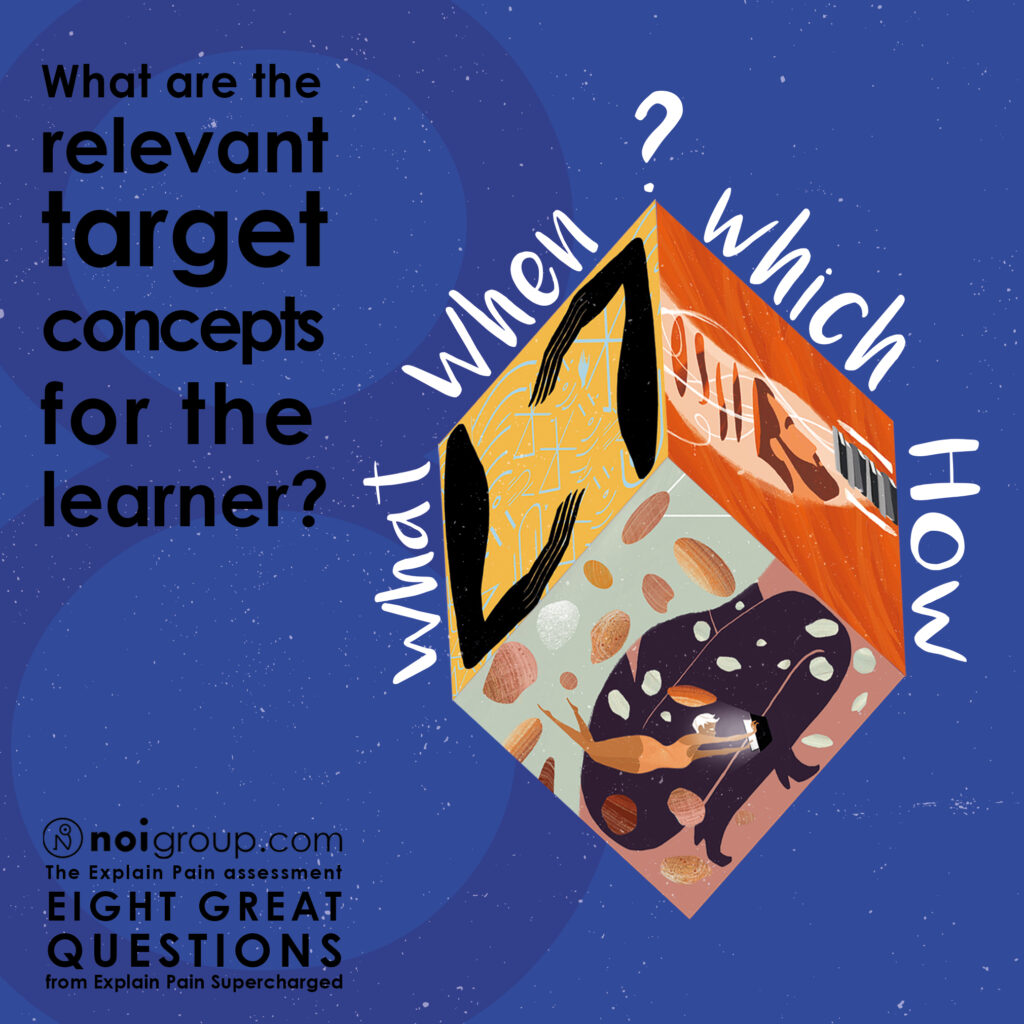
Lets revisit Question Eight in the Explain Pain Assessment Eight Great Questions series. The final question is about weaving the various threads, teased out via the previous seven questions, into a cohesive, integrated and tailored package of education for that individual.
A list of 10 common target concepts
In Explain Pain Supercharged, David and Lorimer provide a list of ten common, universal target concepts that will likely form part of any Explain Pain intervention, but emphasise the need to go beyond this list and add target concepts specific to each patient. The list of common target concepts provide multiple examples to help flesh out what a target concept might look like (that’s a bonus educational science tip – providing multiple examples is a super simple, but highly effective educational strategy)
Which, what, when, how..?
Thinking about target concepts has a number of different facets –which target concepts, what content will I include, how will I deliver them? How many, how long do I spend on each? How can I incorporate multimedia, narrative and metaphor? When do I deliver each target concept – over how many sessions? Here’s another bonus educational tip – in answering these which, what, when, how type questions you are actually building a curriculum – a whole topic in itself for a future series.
Dynamic and nimble
Group settings will lend themselves to predetermined target concepts and you may choose to cover all 10 of the above, but even acute settings can benefit from a few target concepts delivered in the form of quick ‘neuroscience nuggets’.
Educational interventions need to be dynamic and nimble – target concepts can be written down, but they should never be set in stone.
What are your key target concepts? Please share your thoughts!
-NOI Group

My hierarchy of target messages to aid and abet the process – the first big wave or waves that I hope can really weaken those ‘sandcastle fortifications’ – often begin with ” pain as a (over?)protector vs. a gauge or a detector of damage” backing it up with some form of evidence (media, stories, etc). If that sits then other concepts seem much more easily achieved. Thoughts?
There is a lot in that short comment Mike!
We have been thinking about these issues quite a bit. Our proposed general target concepts are not hierarchical, we see the relationships between them as more lateral. However if there was one concept that could be considered overriding, it is that pain is usually more related to the perceived need to protect rather than a damage meter, as you note. We have not stated this in the target concepts list , but it is built into other target concepts. Just seeing how it currently sits clinically and in research.
The notions of the direct sandcastle challenge with this concept fit nicely with the strategy of holistic confrontation in conceptual change. Best with an armoury of images, stories and media to help. Happy to chat further on thus
David
This resonates with me. My office is “downtown” in a small city. I often use the metaphors of walking in the alley behind the office. If you do this at 12:00 PM vs 12:00 AM you will have very different experiences even though the input is the same. After injury, or when the patient is in a DIM state, the same input creates a different physiological experience just as in the alley when your heart rate is elevated, pupils dialated…
Good, practical powerful metaphor which supports target concepts – 5. Pain is completely dependent on context, 6 Pain depends on the perceived balance of safety and danger and 3. there are danger sensors not pain sensors.
Cheers
David